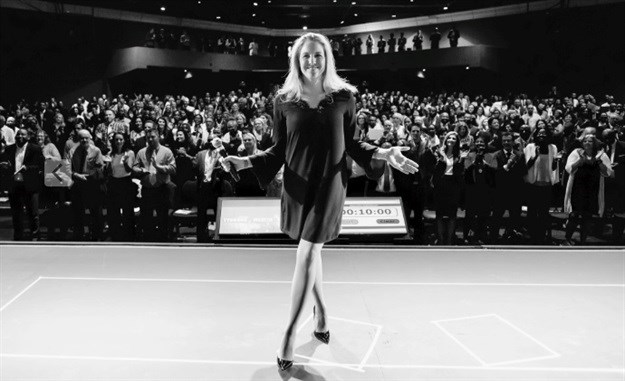
Getting brandalytical with global brand strategist Nadia Boersch

What do you do if your brand seems to have fallen out of favour with consumers? Those in the know turn to brand strategist Nadia Boersch. Having held key leading positions in some of the most successful global brand companies: the most hyped startup Uber, the most successful tobacco company PMI/Marlboro, and the largest health and wellness company Nestlé, she now serves as a global business consultant, sharing her success recipe with brand managers looking to boost their sales – ahem, isn’t that all of us?
Here, she explains her ‘brandalytical’ framework and the challenge of patience in the corporate world for those who are entrepreneurs at heart…
 Talk us through your career highlights and the specific challenges you faced in working on some of the world’s most well-known brands.
Talk us through your career highlights and the specific challenges you faced in working on some of the world’s most well-known brands.
I am eternally grateful for the wonderful opportunities I had in working on each of my brands and truly cherished every moment. The most exciting moments are when you’re working on launches or relaunches and the first numbers come back – is your strategy working or not, do your customers love your campaign or hate it?
I’ve had lots of highlights with each brand, but the top one was based on a campaign and strategy that I created from scratch for a new brand and product launch, with Austria the first market to launch globally.
I was bursting with excitement when the strategy and campaign achieved great results, even more so when it was then presented to the CEO and consequently rolled-out globally.I received an award for the campaign and was so proud of this, as it resulted in the second of three awards I received for my work.
What was challenging for me in general in the corporate world was patience. I’ve always been an entrepreneur at heart, so nothing was ever fast enough or innovative enough.
 Hence your move out of the corporate space. You’ve launched and re-launched more than 15 brands so far. What’s the key to success when relaunching a brand in particular?
Hence your move out of the corporate space. You’ve launched and re-launched more than 15 brands so far. What’s the key to success when relaunching a brand in particular?
I loved creating big-bang launches and relaunches. Relaunching is a very risky business and an endeavour that should not be taken lightly. In the big branding companies, it’s a long process and always involves the senior management team.
The Uber brand, for example, received a facelift in 2016, with the launch of a completely new brand and communication guidelines, so it was important for founder and CEO at the time Travis Kalanick to be involved in every detail of the rebrand process, which took several months and several detours!
If your brand is plummeting because it no longer appeals to customers, rebranding might be the only way back, but you’ll need to do your market research homework diligently. The biggest key to success when rebranding – as with most things in marketing – knowing your customer insights really well, on a better and deeper level than your customers know themselves – then delivering on that in the rebranding.
One of the most successful relaunches in the history of branding was PMI’s Marlboro in 2015. They went all the way to reduce their packaging design to the essence of the brand in its most elegant form: the famous rooftop. The brand had not been touched for more than 60 years since the original Cowboy campaign was invented, yet studies showed it was starting to be seen as old-fashioned.
So the rebranding process needed to manage the shift between maintaining its main value freedom, its premium and iconic image, and the essence of the brand, yet also propel the brand into the 21st Century. Ultimately, the rebrand helped Marlboro rejuvenate the brand and translated into a great success story.
 Let’s take a deep dive into your ‘brandalytical’ formula – how it came about and how to put it into action.
Let’s take a deep dive into your ‘brandalytical’ formula – how it came about and how to put it into action.
The brandalytical formula evolves around the idea of treating your brand like the hottest love affair you’ve ever had, in order to create brand lovers that will buy your product not only once but forever.
The way it was developed is actually a funny story – I was always so passionate about the corporate brands I worked on that my partner at the time actually accused me of having an affair, based on the amount of time and effort I put into “my brands”. My response was: “Yes of course darling, I’m having an affair with my brand!
Essentially, the passion and energy I put into the brands I was working for, and thinking of unique, out-of-the-box ways to engage and grow customers, is why the brands I was working for outperformed in their market. So the brandalytical formula developed out of tools I used to bring that to life.
In today's world, everyone is their own media- @NadiaBoersch's great talk at @GlobalWomanCo @GlobalWomanClub @sulamirela
— Janja Popović (@styljanje) February 26, 2018
#globalwoman #businesswoman #workshop #girlboss #femaleentpreneur pic.twitter.com/BqNR0Lt7qa
- 1. Branding is relevant for every individual, every business, every product, every service and every industry. Every business – regardless of size – can increase its sales success through successful branding.
- 2. Every brand needs to be managed with a strategy. I substantiate the relevance of building a profound brand strategy and to follow up with managing the brand accordingly to boost its performance.
- 3. The secret of success lies in the brandalytical formula, as follows: Partner, passion, excitement, experience, authenticity, attractiveness.
Ultimately, I translate how treating your brand like a love affair increases your brand’s success story.
 As you’re director of the Global Woman Club Vienna and also founded the Women of Influence movement, share a few of the specific career obstacles female entrepreneurs face and how you’ve overcome them.
As you’re director of the Global Woman Club Vienna and also founded the Women of Influence movement, share a few of the specific career obstacles female entrepreneurs face and how you’ve overcome them.
I strongly believe that now more than ever, we’re in the era of the female entrepreneur. There are more opportunities than ever before. Many women approach me with questions on their career and how to build their business, and two of the biggest obstacles they face are the following, which I’ve also struggled with along the way.
First, giving themselves permission to step into their light, and not to be scared that their own shadow will become too big for them because of what others will think of them, or because they’re scared to let down their families or significant others. I was personally scared to step into the light for a very long time, even more so to get comfortable with my growing shadow.
The second challenge is in having the courage to be a powerful female with authentic female energy. I’ve seen it in both the corporate and the entrepreneurial world, where women act like men because they believe it’s the only way to get forward, especially in male-dominated industries.
I tried to stay in my female energy as much as I could, which both had benefits and downfalls. For example, I always wear high heels in business, so the first impression some people had was that I was “a blonde marketing bimbo” – that was until I opened my mouth and turned a brand from plummeting to growing share or came up with campaigns that were rolled out and awarded globally.
It was at times painful, but it was important to me to stay true to myself and fight for being true to my female energy. This was more difficult to do in the corporate world and I still fight for this today, so I appreciate those who compliment me on being successful, yet feminine – I feel I’ve inspired them, which makes it all worthwhile.
It helps to have a great partner, friends, coaches and role models who appreciate you for who you are, both in business and as a woman, who believe in you and keep pushing you forward – that way, you become unstoppable as your shadow grows and grows.
Sounds like a winning strategy, for yourself and your brand. Find out more about Boersch on Brandalytical’s LinkedIn, Twitter, Instagram and YouTube channel for the latest updates.
About Leigh Andrews
View my profile and articles...

![[Relentlessly Relevant] 5. Warning - don't innovate here!](https://biz-file.com/c/1511/320403-120x120.jpg?2)
